Yamaha YDP-131 User Manual
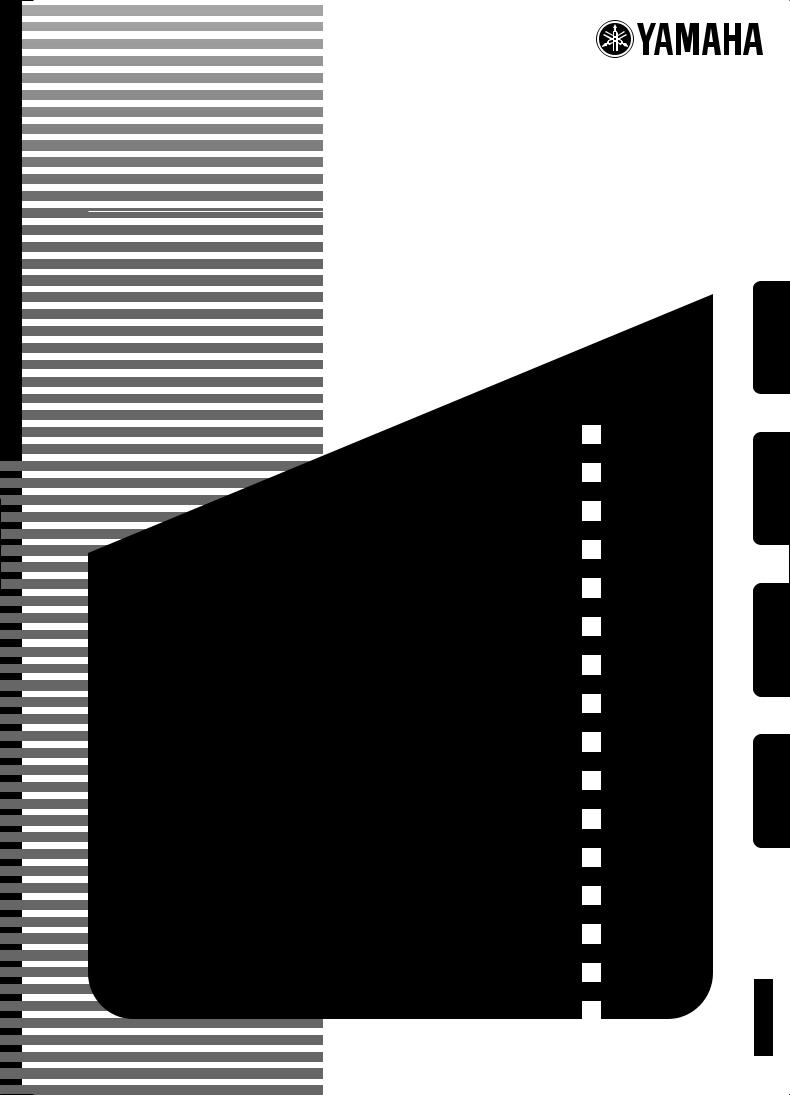
DIGITAL PIANO
YDP-131/YDP-213
Owner's Manual
Bedienungsanleitung
Mode d'emploi
Manual de instrucciones
ENGLISH
ESPAÑOL FRANÇAIS DEUTSCH
EN
DE
FR
ES
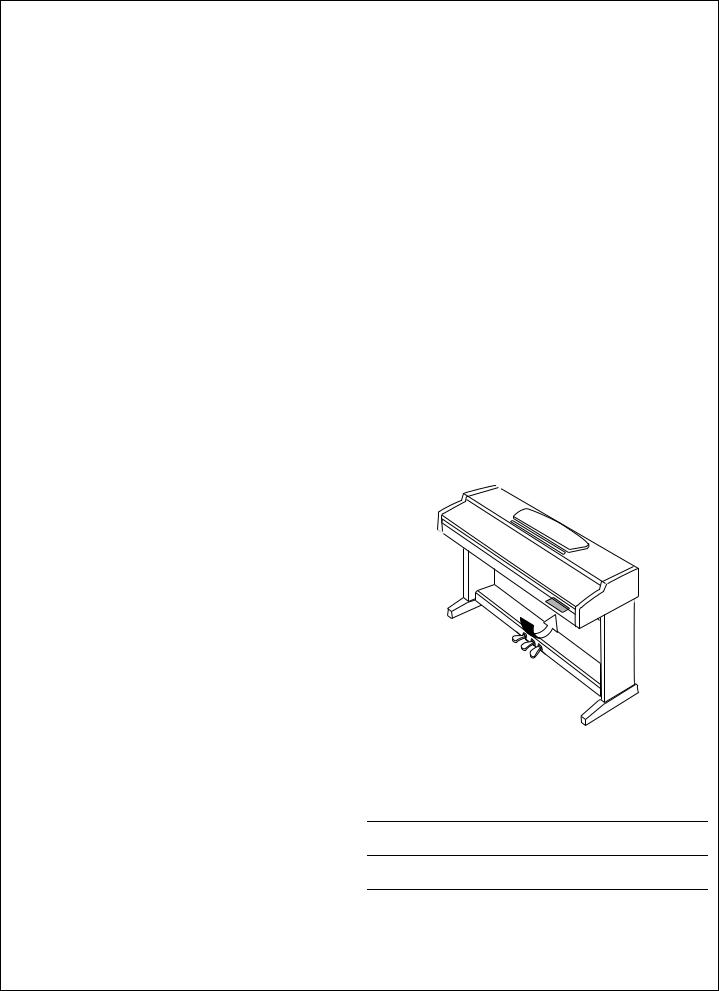
SPECIAL MESSAGE SECTION
This product utilizes batteries or an external power supply (adapter). DO NOT connect this product to any power supply or adapter other than one described in the manual, on the name plate, or specifically recommended by Yamaha.
WARNING: Do not place this product in a position where anyone could walk on, trip over ,or roll anything over power or connecting cords of any kind. The use of an extension cord is not recommended! If you must use an extension cord, the minimum wire size for a 25’ cord (or less ) is 18 AWG. NOTE: The smaller the AWG number ,the larger the current handling capacity. For longer extension cords, consult a local electrician.
This product should be used only with the components supplied or; a cart, rack, or stand that is recommended by Yamaha. If a cart, etc., is used, please observe all safety markings and instructions that accompany the accessory product.
SPECIFICATIONS SUBJECT TO CHANGE:
The information contained in this manual is believed to be correct at the time of printing. However, Yamaha reserves the right to change or modify any of the specifications without notice or obligation to update existing units.
This product, either alone or in combination with an amplifier and headphones or speaker/s, may be capable of producing sound levels that could cause permanent hearing loss. DO NOT operate for long periods of time at a high volume level or at a level that is uncomfortable. If you experience any hearing loss or ringing in the ears, you should consult an audiologist.
IMPORTANT: The louder the sound, the shorter the time period before damage occurs.
Some Yamaha products may have benches and / or accessory mounting fixtures that are either supplied with the product or as optional accessories. Some of these items are designed to be dealer assembled or installed. Please make sure that benches are stable and any optional fixtures (where applicable) are well secured BEFORE using.
Benches supplied by Yamaha are designed for seating only. No other uses are recommended.
NOTICE:
Service charges incurred due to a lack of knowledge relating to how a function or effect works (when the unit is operating as designed) are not covered by the manufacturer’s warranty, and are therefore the owners responsibility. Please study this manual carefully and consult your dealer before requesting service.
ENVIRONMENTAL ISSUES:
Yamaha strives to produce products that are both user safe and environmentally friendly. We sincerely believe that our products and the production methods used to produce them, meet these goals. In keeping with both the letter and the spirit of the law, we want you to be aware of the following:
Battery Notice:
This product MAY contain a small non-rechargeable battery which (if applicable) is soldered in place. The average life span of this type of battery is approximately five years. When replacement becomes necessary, contact a qualified service representative to perform the replacement.
This product may also use “household” type batteries. Some of these may be rechargeable. Make sure that the battery being charged is a rechargeable type and that the charger is intended for the battery being charged.
When installing batteries, do not mix batteries with new, or with batteries of a different type. Batteries MUST be installed correctly. Mismatches or incorrect installation may result in overheating and battery case rupture.
Warning:
Do not attempt to disassemble, or incinerate any battery. Keep all batteries away from children. Dispose of used batteries promptly and as regulated by the laws in your area. Note: Check with any retailer of household type batteries in your area for battery disposal information.
Disposal Notice:
Should this product become damaged beyond repair, or for some reason its useful life is considered to be at an end, please observe all local, state, and federal regulations that relate to the disposal of products that contain lead, batteries, plastics, etc. If your dealer is unable to assist you, please contact Yamaha directly.
NAME PLATE LOCATION:
The name plate is located on the bottom of the product. The model number, serial number, power requirements, etc., are located on this plate. You should record the model number, serial number, and the date of purchase in the spaces provided below and retain this manual as a permanent record of your purchase.
YDP-131/YDP-213
Model
Serial No.
Purchase Date
PLEASE KEEP THIS MANUAL
92-BP (bottom)
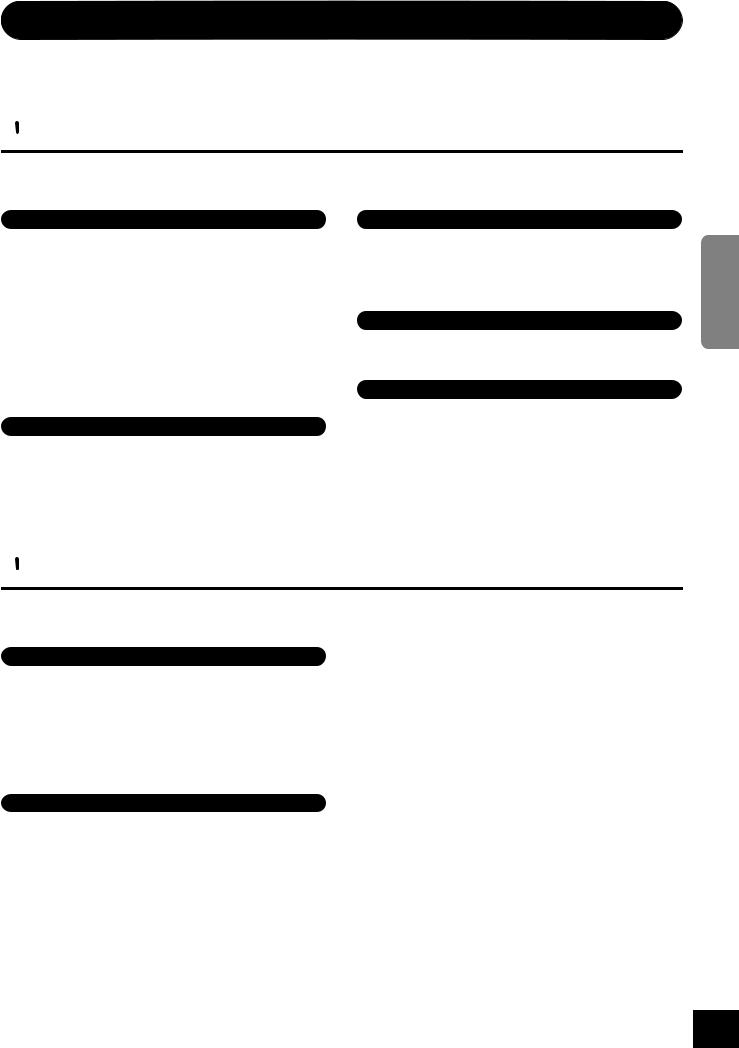
PRECAUTIONS
PLEASE READ CAREFULLY BEFORE PROCEEDING
* Please keep this manual in a safe place for future reference.
 WARNING
WARNING
Always follow the basic precautions listed below to avoid the possibility of serious injury or even death from electrical shock, short-circuiting, damages, fire or other hazards. These precautions include, but are not limited to, the following:
Power supply/AC power adaptor
•Only use the voltage specified as correct for the instrument. The required voltage is printed on the name plate of the instrument.
•Use the specified adaptor (PA-5D or an equivalent recommended by Yamaha) only. Using the wrong adaptor can result in damage to the instrument or overheating.
•Check the electric plug periodically and remove any dirt or dust which may have accumulated on it.
•Do not place the AC adaptor cord near heat sources such as heaters or radiators, and do not excessively bend or otherwise damage the cord, place heavy objects on it, or place it in a position where anyone could walk on, trip over, or roll anything over it.
Do not open
•Do not open the instrument or attempt to disassemble the internal parts or modify them in any way. The instrument contains no user-serviceable parts. If it should appear to be malfunctioning, discontinue use immediately and have it inspected by qualified Yamaha service personnel.
Water warning
•Do not expose the instrument to rain, use it near water or in damp or wet conditions, or place containers on it containing liquids which might spill into any openings.
•Never insert or remove an electric plug with wet hands.
Fire warning
•Do not put burning items, such as candles, on the unit. A burning item may fall over and cause a fire.
If you notice any abnormality
•If the AC adaptor cord or plug becomes frayed or damaged, or if there is a sudden loss of sound during use of the instrument, or if any unusual smells or smoke should appear to be caused by it, immediately turn off the power switch, disconnect the adaptor plug from the outlet, and have the instrument inspected by qualified Yamaha service personnel.
 CAUTION
CAUTION
Always follow the basic precautions listed below to avoid the possibility of physical injury to you or others, or damage to the instrument or other property. These precautions include, but are not limited to, the following:
Power supply/AC power adaptor
•When removing the electric plug from the instrument or an outlet, always hold the plug itself and not the cord.
•Unplug the AC power adaptor when not using the instrument, or during electrical storms.
•Do not connect the instrument to an electrical outlet using a multiple-connector. Doing so can result in lower sound quality, or possibly cause overheating in the outlet.
•Do not place the instrument in an unstable position where it might accidentally fall over.
•Before moving the instrument, remove all connected adaptor and other cables.
•When setting up the instrument, make sure that the AC outlet you are using is easily accessible. If some trouble or malfunction occurs, immediately turn off the power switch and disconnect the plug from the outlet.
•Use only the stand specified for the instrument. When attaching the stand or rack, use the provided screws only. Failure to do so could cause damage to the internal components or result in the instrument falling over.
Location
•Do not expose the instrument to excessive dust or vibrations, or extreme cold or heat (such as in direct sunlight, near a heater, or in a car during the day) to prevent the possibility of panel disfiguration or damage to the internal components.
•Do not use the instrument in the vicinity of a TV, radio, stereo equipment, mobile phone, or other electric devices. Otherwise, the instrument, TV, or radio may generate noise.
(3)-9 1/2
ENGLISH
1
YDP-131/YDP-213 PRECAUTIONS 3
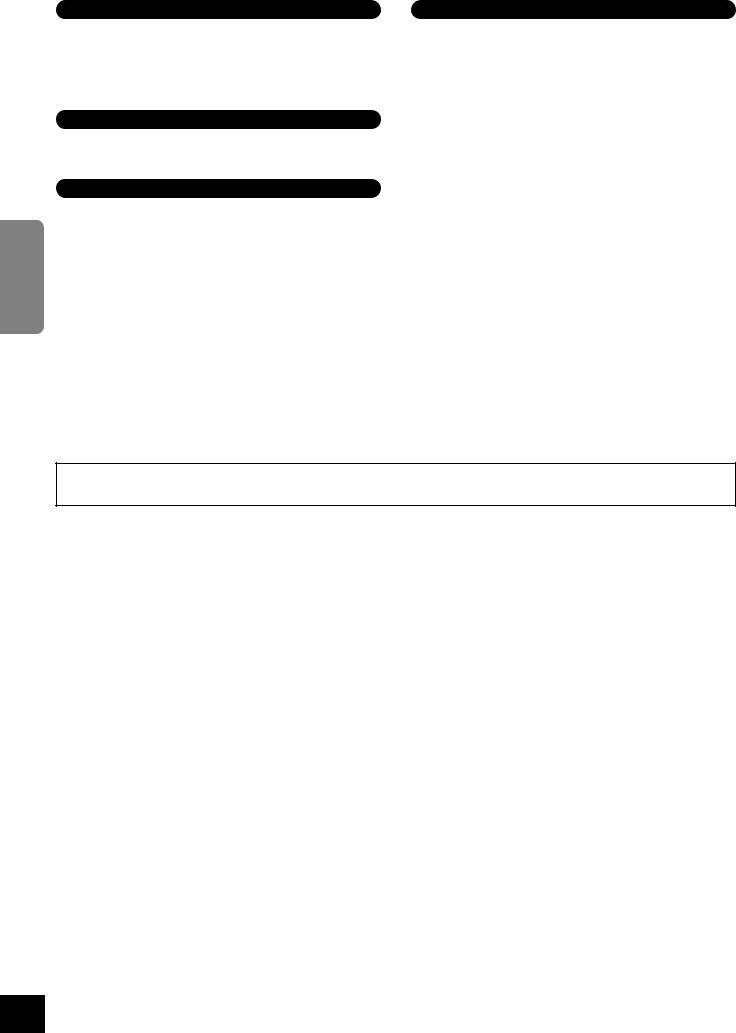
ENGLISH
|
Connections |
|
|
Saving data |
|
• Before connecting the instrument to other electronic components, turn off the |
Saving and backing up your data |
||||
|
power for all components. Before turning the power on or off for all |
• Data in the instrument’s internal memory can be lost due to operational errors or |
|||
|
components, set all volume levels to minimum. Also, be sure to set the volumes |
||||
|
|
malfunction. Be sure to save any important data to external media via a |
|||
|
of all components at their minimum levels and gradually raise the volume |
|
|||
|
|
computer connected to the instrument. (page 31) |
|||
|
controls while playing the instrument to set the desired listening level. |
|
|||
|
|
|
|
||
Maintenance
•When cleaning the instrument, use a soft, dry cloth. Do not use paint thinners, solvents, cleaning fluids, or chemical-impregnated wiping cloths.
Handling caution
•Take care that the key cover does not pinch your fingers, and do not insert a finger or hand in any gaps on the key cover or instrument.
•Never insert or drop paper, metallic, or other objects into the gaps on the key cover, panel or keyboard. If this happens, turn off the power immediately and unplug the power cord from the AC outlet. Then have the instrument inspected by qualified Yamaha service personnel.
•Do not place vinyl, plastic or rubber objects on the instrument, since this might discolor the panel or keyboard.
•Do not rest your weight on, or place heavy objects on the instrument, and do not use excessive force on the buttons, switches or connectors.
•Do not operate the instrument for a long period of time at a high or uncomfortable volume level, since this can cause permanent hearing loss. If you experience any hearing loss or ringing in the ears, consult a physician.
Yamaha cannot be held responsible for damage caused by improper use or modifications to the instrument, or data that is lost or destroyed.
Always turn the power off when the instrument is not in use.
Even when the power switch is in the “STANDBY” position, electricity is still flowing to the instrument at the minimum level. When you are not using the instrument for a long time, make sure you unplug the AC power adaptor from the wall AC outlet.
(3)-9 2/2
4 YDP-131/YDP-213 PRECAUTIONS
2
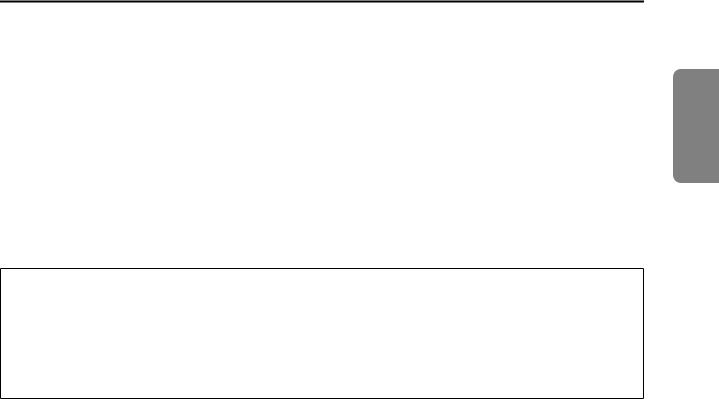
Welcome
Thank you for purchasing the Yamaha Digital Piano! We recommend that you read this manual carefully so that you can take full advantage of the advanced and convenient functions of your new digital piano.
We also recommend that you keep this manual in a safe, convenient place for future reference.
About this Owner’s Manual
This manual consists of three main sections: “Introduction,” “Reference” and “Appendix.”
 Introduction (page 2):
Introduction (page 2):
Please read this section first.
 Reference (page 13):
Reference (page 13):
This section explains how to make detailed settings for the instrument’s various functions.
 Appendix (page 39):
Appendix (page 39):
This section introduces reference material.
*The illustrations as shown in this owner’s manual are for instructional purposes only, and may be different from the ones on your instrument.
COPYRIGHT NOTICE
This product incorporates and bundles computer programs and contents in which Yamaha owns copyrights or with respect to which it has license to use others’ copyrights. Such copyrighted materials include, without limitation, all computer software, MIDI files and WAVE data. Any unauthorized use of such programs and contents outside of personal use is not permitted under relevant laws. Any violation of copyright has legal consequences. DON’T MAKE, DISTRIBUTE OR USE ILLEGAL COPIES.
Copying of the commercially available software is strictly prohibited except for your personal use.
Trademarks:
•Apple and Macintosh are trademarks of Apple Computer, Inc.
•Windows is a registered trademark of Microsoft® Corporation.
•All other trademarks are the property of their respective holders.
ENGLISH
3
YDP-131/YDP-213 About this Owner’s Manual |
5 |
|
|

ENGLISH
Table of Contents
Introduction |
|
SPECIAL MESSAGE SECTION ...................... |
2 |
PRECAUTIONS............................................. |
3 |
About this Owner’s Manual........................ |
5 |
Application Index........................................ |
7 |
Accessories .................................................. |
8 |
Maintenance ............................................... |
8 |
Features....................................................... |
9 |
Before Using the Digital Piano ................. |
10 |
Key Cover ........................................................... |
10 |
Music Rest .......................................................... |
10 |
Turning the Power On....................................... |
11 |
Setting the Volume............................................. |
12 |
Using Headphones ............................................. |
12 |
Reference |
|
Part Names................................................ |
14 |
Listening to the Demo Songs ................... |
15 |
Listening to 50 Piano Preset Songs .......... |
16 |
Listening to Songs Loaded from the |
|
Computer ............................................... |
17 |
Selecting & Playing Voices........................ |
18 |
Selecting Voices .................................................. |
18 |
Using the Pedals ................................................. |
19 |
Adding Variations to the Sound – Reverb ........ |
20 |
Layering Two Voices (Dual mode) ................... |
21 |
Transposition ..................................................... |
22 |
Fine-tuning the Pitch ......................................... |
22 |
Using the Metronome........................................ |
23 |
Adjusting the Keyboard Touch |
|
(Touch Sensitivity) ........................................ |
24 |
Recording your Performance.................... |
25 |
Playing Back Recorded Performance Data ....... |
26 |
Connecting MIDI Instruments.................. |
27 |
About MIDI........................................................ |
27 |
MIDI’s Capability............................................... |
27 |
Connecting the Digital Piano to a |
|
Computer ............................................... |
28 |
MIDI Functions.......................................... |
29 |
MIDI Transmit/Receive Channel Selection...... |
29 |
Local Control ON/OFF...................................... |
29 |
Program Change ON/OFF................................. |
30 |
Control Change ON/OFF .................................. |
30 |
Transmitting Song Data between the |
|
Computer and the Digital Piano ............ |
31 |
Loading Song Data from a Computer to the |
|
Digital Piano .................................................. |
31 |
Transmitting Song Data from the Digital Piano |
|
to a Computer ............................................... |
31 |
Backing up Data and Initializing the Settings .. |
32 |
Troubleshooting........................................ |
33 |
Options...................................................... |
33 |
Keyboard Stand Assembly ........................ |
34 |
Index.......................................................... |
37 |
Appendix |
|
MIDI Data Format .................................... |
40 |
MIDI Implementation Chart .................... |
44 |
Specifications ........................................... |
45 |
6 |
YDP-131/YDP-213 Table of Contents |
|
|
4
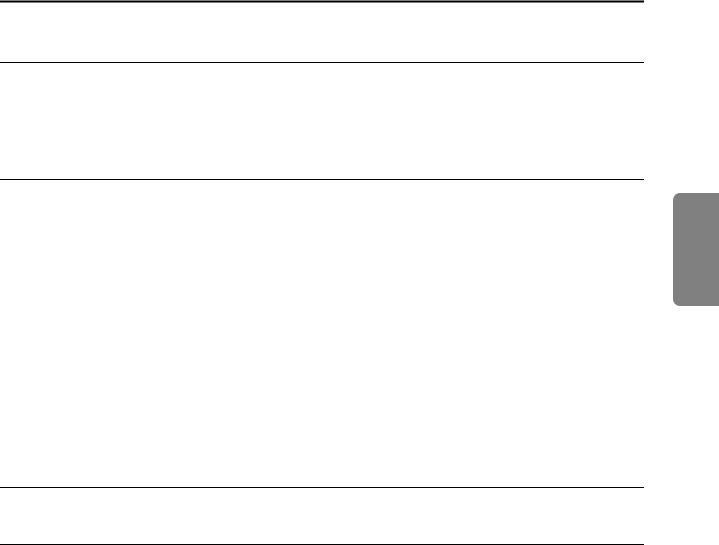
Application Index
Use this index to find reference pages that may be helpful for your particular application and situation.
Listening
Listening to demo songs with different voices...................................................... |
“Listening to the Demo Songs” on page 15 |
Listening to songs from “50 Greats for the Piano” ...................................... |
“Listening to 50 Piano Preset Songs” on page 16 |
Listening to recorded performances................................................. |
“Playing Back Recorded Performance Data” on page 26 |
Listening to songs loaded from the computer ......................... |
“Listening to Songs Loaded from the Computer” on page 17 |
Playing
Using three pedals ....................................................................................................................... |
“Using the Pedals” on page 19 |
Shifting the pitch of the keyboard up or down in semitone steps ................................................ |
“Transposition” on page 22 |
Fine-tuning the pitch of the entire instrument when you play this instrument |
|
along with other instruments or CD music....................................................................... |
“Fine-tuning the Pitch” on page 22 |
Adjusting the key touch response (sensitivity) for changing the volume
.............................................................................................. |
“Adjusting the Keyboard Touch (Touch Sensitivity)” on page 24 |
Changing voices |
|
|
|
Viewing the list of voices..................................................................................................... |
........ “Selecting Voices” on page 18 |
Simulating a concert hall .................................................................... |
“Adding Variations to the Sound – Reverb” on page 20 |
Combining two voices.................................................................................... |
“Layering Two Voices (Dual mode)” on page 21 |
Practicing |
|
|
|
Practicing with an accurate and steady tempo .................................................................“Using the Metronome” on page 23
Recording
Recording your performances ............................................................................... “Recording your Performance” on page 25
Connecting this instrument to other devices
What is MIDI? ..................................................................................................... |
“Connecting MIDI Instruments” on page 27 |
Connecting the computer ............................................................ |
“Connecting the Digital Piano to a Computer” on page 28 |
Transmitting the recording of your performance to a computer
..........................................................................“Transmitting Song Data from the Digital Piano to a Computer” on page 31
Transmitting song data from a computer to the instrument
.................................................................................. |
“Loading Song Data from a Computer to the Digital Piano” on page 31 |
Assembling |
|
|
|
Assembling and disassembling this instrument.................................................. |
“Keyboard Stand Assembly” on pages 34–36 |
ENGLISH
5
YDP-131/YDP-213 Application Index |
7 |
|
|

ENGLISH
Accessories
•“50 Greats for the Piano” (Music Book)
•Owner’s Manual
This manual contains complete instructions for operating your digital piano.
•Quick Operation Guide
•Assembly parts
Maintenance
Clean the instrument using a dry or slightly damp soft cloth (wring well).
 CAUTION
CAUTION
Do not use benzene, thinner, detergent, or chemically-treated cloth for cleaning. Do not place vinyl, plastic or rubber products on the instrument.
Otherwise, the panel or keys may become discolored or degraded.
 CAUTION
CAUTION
Before using this instrument, be sure to read “Precautions” on pages 3 – 4.
 Tuning
Tuning
Unlike an acoustic piano, this instrument does not need to be tuned. It always stays perfectly in tune.
 Transporting
Transporting
If you move to another location, you can transport this instrument along with your other belongings. You can move the unit as it is (assembled) or you can disassemble the unit before moving.
Transport the keyboard horizontally. Do not lean it up against a wall or stand it up on its side. Do not subject the instrument to excessive vibration or shock.
8 YDP-131/YDP-213 Accessories
6

Features
The Yamaha YDP-131/YDP-213 digital piano features a special “GHS (Graded Hammer Standard)” keyboard that offers natural grand-piano type playability.
This keyboard adheres to the basic principle of the “Graded Hammer” keyboard, which was developed through extensive research for the best grand piano sound, while providing a weighted keyboard response that is graduated from the low range to the high range (i.e., lower keys are weighted more heavily). As a result, the YDP-131/YDP-213 provides unmatched sonic realism and natural grand-piano type playability.
The sound source of the YDP-131/YDP-213 uses Yamaha’s original “AWM Stereo Sampling” tone-generation technology for rich and musical voices.
Two of the piano voices, “Grand Piano 1” and “Grand Piano 2,” feature totally new samples recorded from a full-size concert grand piano. The “Electric Piano” voice features multiple samples for different velocities (Dynamic Sampling); that is, different samples are used depending on how fast or strong you strike the keys.
This digital piano sounds much closer to a true acoustic piano.
[PHONES]
A set of standard stereo
........headphones can be plugged in here for private practice
(page 12).
PHONES
MIDI [IN/OUT] |
|
|
...... |
|
|
Connect a MIDI device to this connector to use various MIDI functions |
||
(pages 27–28). (Connecting MIDI Instruments—page 27) |
||
MIDI |
|
PEDAL |
|
|
........ |
|
|
[PEDAL] |
|
|
Connect the pedal cord |
OUT |
IN |
(page 35). |
|
||
[DEMO/SONG] |
Listen to the playback of a demo song for each voice and 50 piano preset songs (page 15).
[PIANO/VOICE] |
........ |
Select a demo song for each voice, or |
|
Select one of 6 internal sounds, including |
[SELECT] |
||
|
|||
Grand Piano 1 and 2 (page 18). |
|
one of the 50 piano preset songs |
|
(page 21) or select various reverb effects |
|||
........ |
|||
You can also layer two voices together |
(page 15 and 16). You can also select a |
||
|
|
||
(page 20). |
........ |
different voice while the song playback is |
|
stopped. |
|||
|
|||
[REC] |
|
||
Record your performance (page 25). |
[METRONOME] |
|
........ |
||
[PLAY] |
Control the metronome functions (page |
|
23). |
||
Play back your recorded performance |
||
........ |
||
(page 26). |
||
|
||
|
[MASTER VOLUME] |
|
|
Adjust the volume level using this control |
|
|
(page 12). |
ENGLISH
7
YDP-131/YDP-213 Features 9
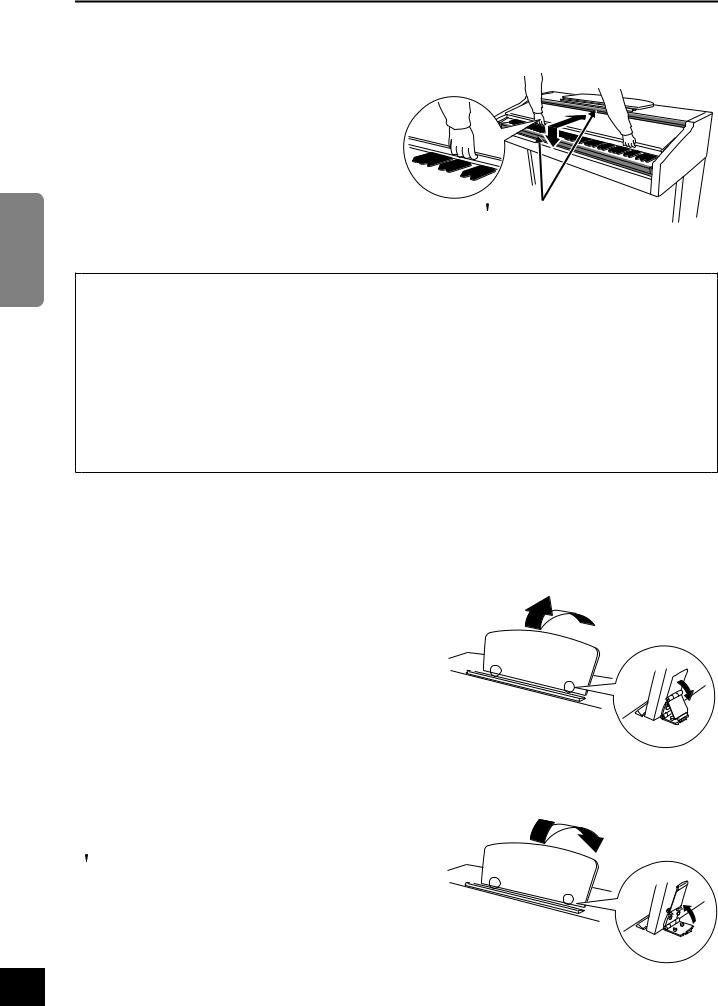
ENGLISH
Before Using the Digital Piano
 Key Cover
Key Cover
To open the key cover:
Lift the cover slightly, then push and slide it open.
To close the key cover:
Slide the cover toward you and gently lower the cover over the keys.
 CAUTION
CAUTION
Be careful to avoid catching your fingers when opening or closing the cover.
 CAUTION
CAUTION
Hold the cover with both hands when opening or closing it. Do not release it until it is fully opened or closed. Be careful to avoid catching fingers (yours or others, especially children’s) between the cover and main unit.
 CAUTION
CAUTION
Do not place objects, such as a piece of metal or paper, on top of the key cover. Small objects placed on the key cover may fall inside the unit when the cover is opened and may be nearly impossible to remove. This could cause electric shock, short circuit, fire or other serious damage to the instrument.
If this happens, turn off the power immediately and unplug the power cord from the AC outlet. Then have the instrument inspected by qualified Yamaha service personnel.
 Music Rest
Music Rest
To raise the music rest:
1.Pull the music rest up and toward yourself as far as it will go.
2.Flip down the two metal supports at the left and right on the
rear of the music rest.
3. Lower the music rest so that it rests on the metal supports.
To lower the music rest:
1.Pull the music rest toward yourself as far as it will go.
2.Raise the two metal supports (at the rear of the music rest).
3. Gently lower the music rest backward until it is all the way down.
 CAUTION
CAUTION
Do not try to use the music rest in a half-raised position.
When lowering the music rest, do not release your hands from the music rest until it is all the way down.
10 YDP-131/YDP-213 Before Using the Digital Piano
8
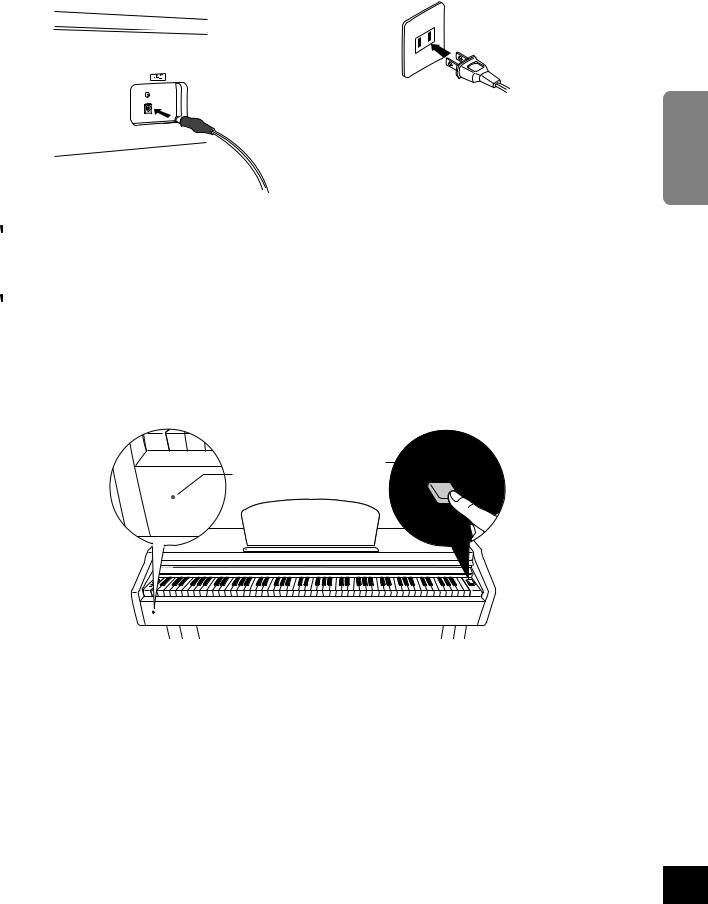
 Turning the Power On
Turning the Power On
1. Connect the power adapter.
1-1
1-2
1-3
1-2 |
1-3 |
(The shape of the plug differs depending on locale.)
ENGLISH
 WARNING
WARNING
Use ONLY a Yamaha PA-5D AC Power Adaptor (or other adaptor specifically recommended by Yamaha) to power your instrument from the AC mains. The use of other adaptors may result in irreparable damage to both the adaptor and the instrument.
 WARNING
WARNING
Unplug the AC Power Adaptor when not using the instrument, or during electrical storms.
2.Turn the power on.
Press the [STANDBY/ON] button.
• The power indicator located below the left end of the keyboard lights up.
[STANDBY/ON]
Power indicator
To turn the power off, press the [STANDBY/ON] button again.
• The power indicator turns off.
 CAUTION
CAUTION
Even when the switch is in the “STANDBY” position, electricity is still flowing to the instrument at a minimum level. When not using the instrument for an extended period of time, be sure to unplug the AC power adaptor from the wall AC outlet.
Power indicator
If you forget to turn off the power to the piano and close the key cover, the power indicator will remain lit, indicating that the power is still on.
9
YDP-131/YDP-213 Before Using the Digital Piano 11

ENGLISH
 Setting the Volume
Setting the Volume
When you start playing, adjust the [MASTER VOLUME] control to the most comfortable listening level.
The level decreases. |
The level increases. |
 CAUTION
CAUTION
Do not use this instrument at a high volume level for a long period of time, or your hearing may be damaged.
 Using Headphones
Using Headphones
Connect a pair of headphones to one of the [PHONES] jacks. Two [PHONES] jacks are provided.
You can connect two sets of standard stereo headphones. (If you are using only one pair of headphones, you can plug them into either jack.)
bottom surface
PHONES
standard stereo phone plug
12 YDP-131/YDP-213 Before Using the Digital Piano
10

Reference |
This section explains how to make detailed settings for this |
|
|
|
instrument’s various functions. |
Part Names................................................................ |
14 |
Listening to the Demo Songs................................... |
15 |
Listening to 50 Piano Preset Songs.......................... |
16 |
Listening to Songs Loaded from the Computer ..... |
17 |
Selecting & Playing Voices ....................................... |
18 |
Selecting Voices ........................................................... |
18 |
Using the Pedals .......................................................... |
19 |
Adding Variations to the Sound – Reverb.................. |
20 |
Layering Two Voices (Dual mode) ............................. |
21 |
Transposition............................................................... |
22 |
Fine-tuning the Pitch .................................................. |
22 |
Using the Metronome ................................................. |
23 |
Adjusting the Keyboard Touch (Touch Sensitivity) .. |
24 |
Recording your Performance................................... |
25 |
Playing Back Recorded Performance Data ................ |
26 |
Connecting MIDI Instruments ............................... |
27 |
About MIDI................................................................. |
27 |
MIDI’s Capability........................................................ |
27 |
Connecting the Digital Piano to a Computer ................ |
28 |
MIDI Functions........................................................ |
29 |
MIDI Transmit/Receive Channel Selection ............... |
29 |
Local Control ON/OFF............................................... |
29 |
Program Change ON/OFF ......................................... |
30 |
Control Change ON/OFF ........................................... |
30 |
Transmitting Song Data between the Computer and |
|
the Digital Piano....................................................... |
31 |
Loading Song Data from a Computer to the Digital |
|
Piano ........................................................................ |
31 |
Transmitting Song Data from the Digital Piano to a |
|
Computer................................................................. |
31 |
Backing up Data and Initializing the Settings ........... |
32 |
Troubleshooting ....................................................... |
33 |
Options ..................................................................... |
33 |
Keyboard Stand Assembly ....................................... |
34 |
Index ......................................................................... |
37 |
ENGLISH
11
YDP-131/YDP-213 13
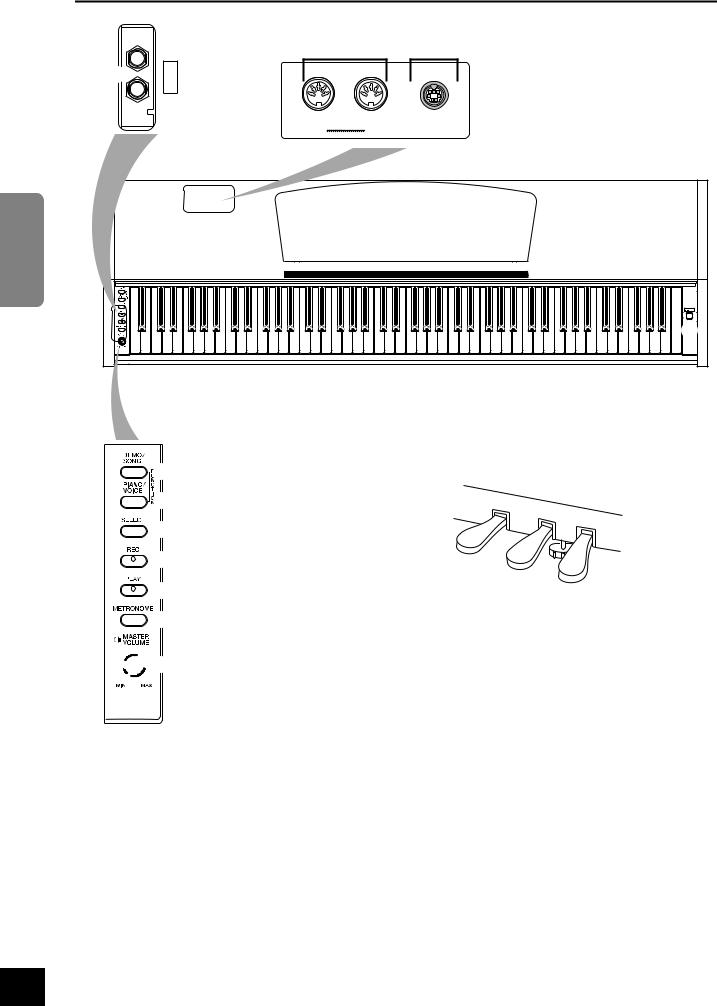
Part Names
|
PHONES |
0 |
A |
|
9 |
MIDI |
PEDAL |
||
|
||||
|
|
|||
|
|
OUT |
IN |
|
ENGLISH |
|
|
|
|
|
|
|
1 |
2 |
|
|
3 |
|
|
4 |
|
|
5 |
B |
|
|
||
6 |
C |
|
D |
||
|
||
7 |
|
 8
8
1 |
[STANDBY/ON] |
............................. P11 |
8 |
[MASTER VOLUME]....................... |
P12 |
2 |
[DEMO/SONG] ............................. |
P15 |
9 |
[PHONES] ..................................... |
P12 |
3 |
[PIANO/VOICE] ........................ |
P18–21 |
0 MIDI [IN] [OUT]............................ |
P27 |
|
4 |
[SELECT] ........................... |
P15, 16, 18 |
A [PEDAL]......................................... |
P35 |
|
5 |
[REC]............................................. |
P25 |
B Soft (Left) Pedal ............................ |
P19 |
|
6 |
[PLAY] ..................................... |
P25, 26 |
C Sostenute (Center) Pedal............... |
P19 |
|
7 |
[METRONOME]............................. |
P23 |
D Damper (Right) Pedal ................... |
P19 |
|
14 YDP-131/YDP-213 Part Names
12

Listening to the Demo Songs
Demo songs are provided that effectively demonstrate each of this instrument’s voices.
Procedure
1. Turn on the power.
(In case the power is not turned ON) Press the [STANDBY/ON] button. When you start playing, adjust the [MASTER VOLUME] control to the most comfortable listening level.
2. Start playing back a demo song.
Press the [DEMO/SONG] button.
The demo song for the currently-selected voice starts playing.
3. Select and play a demo song.
While a demo song is playing, press the [SELECT] button to select and play the next demo song.
If you wish to select a particular demo song from 6 voice demo songs, while holding down the [DEMO/SONG] button, press one of the C1–F1 keys.
The selected demo song starts to play. Starting with the selected song, the playback of the demo songs will continue in the following sequence: other voice demo songs, followed by 50 piano preset songs, and any songs loaded from the computer. The sequence then returns to the first demo song and repeats until you stop it.
The lowest key |
C1 F1 |
Demo Songs
Each of the 6 voices features its own demo song that showcases the corresponding voice. Please refer to “Selecting Voices” on page 18.
The demo songs listed below are re-arranged excerpts from the original compositions.
The other demo songs are Yamaha’s original pieces (©2005 Yamaha Corporation).
Key |
Voice Name |
Title |
Composer |
|
|
|
|
C1 |
GrandPiano1 |
“Eintritt” Waldszenen Op.82 |
R. Schumann |
D 1 |
Harpsichord |
Gavotte |
J.S. Bach |
Adjusting the Volume
Use the [MASTER VOLUME] control to adjust the volume.
4. Stop the Voice demo.
Press the [DEMO/SONG] button to stop playback.
Refer to the voice list on
page 18 for more information on the characteristics of each preset voice.
You cannot adjust the tempo of demo songs.
The demo songs will not be transmitted via MIDI.
ENGLISH
13
YDP-131/YDP-213 Listening to the Demo Songs 15
